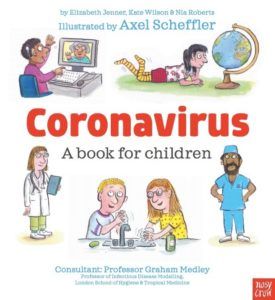
6 Free Children’s Ebooks on the Coronavirus
Understanding COVID-19, self-quarantine, and social distancing is difficult enough when you’re an adult. What about if you’re a child?
Is there an easy way to explain to kids why school suddenly let out in the middle of the school year, why people are wearing masks everywhere, and why parents are now working from home? I’m not sure if “easy” is the right word, but thankfully, many authors and illustrators have created some wonderful children’s books with the express purpose of explaining the coronavirus to kids. Many of them are written by medical professionals.
And the best part is, all of these books are absolutely free, which means you can download them right now and start reading them to your children tonight!
 Why We Stay Home by Samantha Harris, Devon Scott, and Harriet Rodis
Why We Stay Home by Samantha Harris, Devon Scott, and Harriet Rodis
In Why We Stay Home, siblings Suzie and Millie have to stay home with their parents. When younger sister Suzie expresses her excitement, Millie explains the coronavirus to her.
Harris and Scott are medical students from Loma Linda University School of Medicine in Southern California. This is their first book together, but they hope to make an entire series of Millie and Suzie learning about the human body. Why We Stay Home is also available in French, Spanish, Italian, and Portuguese!
Bray Bray Conquers the Coronavirus by Ashley Maxie-Moreman and Joanah Whitely
This is the second book in the Adventures of Bray Bray Series, which author Maxie-Moreman created when she wanted more books with black boy protagonists for her nephews.
In the book, Bray Bray learns there are several things he can do to help fight coronavirus, like wash his hands, stay home, and listen to his parents. The last page includes a blank list where children can write down their own ways to conquer the coronavirus if they feel inspired by Bray Bray.
 My hero Is You by Helen Patuck
My hero Is You by Helen Patuck
A project by the Inter-Agency Standing Committee’s Reference Group on Mental Health, My Hero Is You follows Sara and her magical dragon Ario as they fly around the world, teaching others about the coronavirus.
The book is the result of a global survey of 1,700 children, parents, and caregivers, conducted in five different languages, that assessed children’s mental health responses to the outbreak. Themes from the survey were crafted into the book’s narrative, and then children and parents gave feedback on the story.
We’re Going to be Okay by Ebony Jade Hilton, Leigh-Ann Webb, and Ashleigh Corrin Webb
Written by two physicians at UVA Health in Virginia, We’re Going to Be Okay was written specifically for communities of color, which have been disproportionately affected by COVID-19.
In the book, Parker is excited to go to school until he finds out that school will be closed for a while. “Doctor Mom” then explains all about the virus and the ways that Parker and his family can keep themselves—and other people—safe.
 Coronavirus: A Book for Children by Elizabeth Jenner, Kate Wilson, Nia Roberts, and Axel Scheffler
Coronavirus: A Book for Children by Elizabeth Jenner, Kate Wilson, Nia Roberts, and Axel Scheffler
In this straightforward and informative book, German illustrator Axel Scheffler (The Gruffalo) lends his talents to giving visual representation to the pandemic.
The book was published by Nosy Crow in consultation with the London School of Hygiene & Tropical Medicine, a child psychologist, and two teachers. It answers many questions children might have about the virus, like how it’s spread, what to do if you catch it, and whether or not there’s a cure.
What Color Is Today? by Alison Stephen
In this imaginative book inspired by Dr. Seuss’s My Many Colored Days, Stephens focuses on the psychology of color and how it pertains to mood. Days are labeled things like “Scary Blue,” “Angry Red,” or “Gloomy, Gloomy, Gray.”
In the end, though, the children in the book realize that it’s okay to feel many colors at once, and their feelings create a rainbow of support for essential workers.
Also In This Story Stream
- Book Clubbing During A Pandemic: The Online/Offline Experience
- Support And Hope In The Philadelphia Book Scene
- Why Are Chicago Public Libraries Still Open Amid Soaring COVID Rates?
- How to Make a Children’s Book Museum COVID-Compliant
- How the Pandemic Has Changed Our Reading Lives
- Libraries Reopen in COVID-19 Hot Spots: Are Library Staff Being Protected?
- Quaranzines are Popular and Libraries are Noticing
- A New Role for Little Free Libraries
- As Bookstores Reopen, Stores Seek Safe Practices
- Librarians in Phoenix Become Healthcare Workers



 Why We Stay Home
Why We Stay Home My hero Is You
My hero Is You Coronavirus: A Book for Children
Coronavirus: A Book for Children







